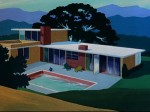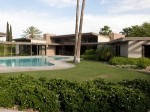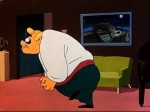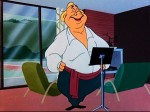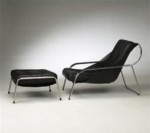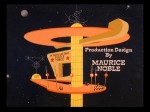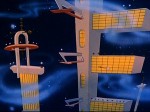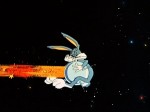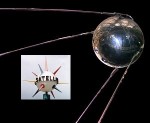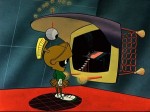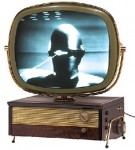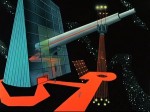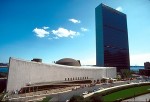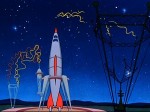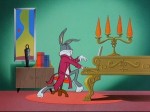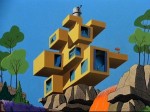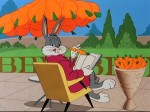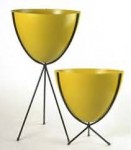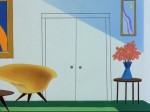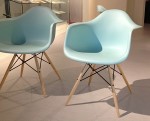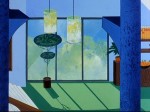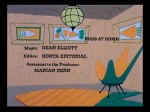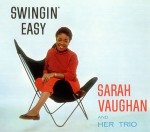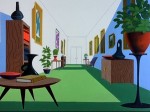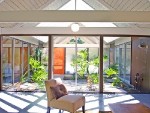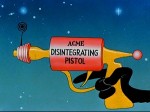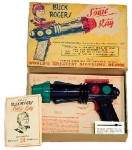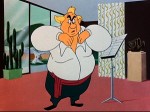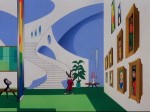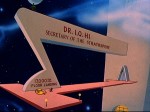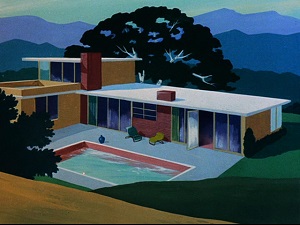
Was Giovanni Jones’ house patterned after Frank Sinatra’s Palm Springs home?
Art can sometimes become an unintended homage to current designs in architecture, industrial design and consumer goods. As someone who has a fondness for mid century modern design, I couldn’t help noticed the many references to modern architecture in several Bugs Bunny cartoons produced in the 1940’s, 50’s and 1979.
Mid century modern design seeps into Bugs Bunny cartoons
The post war boom and reinvention of America with mid century modern architecture is most evident in the Bugs’ cartoon Long – Haired Hare in 1949. A folk-tune singing Bugs Bunny tangles with the high-brow opera star Giovanni Jones. At this point, Bugs Bunny cartoons were pulling in current events that resonated with the audience. (Click on picture thumbnails to enlarge)
Long-Haired Hare
Opera and classical music was much more widely played and appreciated than it is today. The NBC Symphony Orchestra was a regular prime time feature on TV. Conductor Leopold Stokowski was a conductor for the NBC Orchestra and started the Hollywood Bowl Symphony Orchestra in 1945 where the final scene of the cartoon is set.
Hollywood vacationed in Palm Springs
The house where Giovanni Jones is practicing closely resembles Frank Sinatra’s Palm Springs home that was completed in 1947. Interior furnishings and drapes also display a mid-century modern flourish. While many case study homes had been built in southern California with a modern design, the Sinatra house would have been most familiar to people across America.
Modernist painting from 1897 pops up
Completely unexpected to me was finding a rendering of Henri Rousseau’s The Sleeping Gypsy depicted in the house of Giovanni Jones. Aside from the fact that this painting depicts a musician in the desert, what other statement could the inclusion of the 1897 painting be making? Rousseau was a self-taught artist who used a modern style in his paintings.
Pete Alvarado was the background artist on this particular cartoon. He attended the Chouinard Art Institute in Los Angeles. As a Hispanic man born in New Mexico, The Sleeping Gypsy may have had special meaning from an artist’s perspective (simple background, flat but colorful subjects) and because Rousseau was self-taught like so many other animators. The Sleeping Gypsy scene was also used in an episode of The Simpsons “Mom And Pop Art“.
Mid century modern chairs
Giovanni is shown practicing in the mid century modern house with stylized modern chairs and curtains. The closest I could find to chairs that were being produced in that era was the Maggiolina designed by Marco Zanuso in 1947. The curtain behind Giovanni has an elongated “S” (for Sinatra?) and a repeating pattern reminiscent of wood and concrete screens used in many Palm Springs homes at the time.
Googie in outer space
In the 1958 cartoon Hare-Way to the Stars , the animators capitalized on the modern “space age” industrial design that was the hot trend in new buildings along with the launch of the Russian Sputnik satellite and nuclear Armageddon. Bugs Bunny thwarts Marvin the Martian’s attempts to blow up earth with Illudium PU-36 with typical hide-seek-bonk chase scenes. Set in outer space, the blank space canvas was perfect for incorporating mid century modern Googie design popular at the time.
Sputnik and Satellites fly through Bugs Bunny cartoon
Sputnik was launch on October 4, 1957 and by March 29, 1958 Warner Brothers had released Hare-Way to the Stars incorporating the tiny satellite. Southern California would become home to many “space age” themed designs as several military and space program contractors were based in the area. A multi-pointed satellite orb adorned the top of the Satellite Shopping Center in Anaheim.
TV’s in out space
It’s hard to say if Marvin the Martian’s TV inspired Philco’s Predicta Television or the other way around. The Predicta, with its swivel tube, was released in 1958. They were a slow seller possibly because of the modern design. All models were black and white unlike Marvin’s which was in color.
Walls of glass
The 1950’s were the embryonic years for style of skyscrapers that sported walls of glass on all sides. One of the most famous of the time was the United Nations Secretariat building design by Le Corbusier and Oscar Niemeyer completed in 1954. Both Le Corbusier and Niemeyer were in the fore front of modern architecture.
Globes of Glass
It seems like every element in a Bugs Bunny cartoon has a double meaning. The animators liberally sprinkled the popular white glass globes that had become popular in a variety of building settings throughout the cartoon. Globes of glass obviously represented the earth, shining beacons, stars and the modern influence in commercial design.
New rabbit ear antennas for new TVs
Director Chuck Jones and all the animators were surrounded by Googie architecture, space age toys and real world mid century modern consumer products. There were lots of images from their homes, driving to work or on a vacation to Palm Springs or Las Vegas that could provide inspiration for outer space designs.
Bugs Bunny was mid century modern
One of the largest collections of mid century modern images occurs not during the hey-day of Bugs Bunny cartoons, but in the 1979 The Bugs Bunny Road Runner Movie. The new animation featuring iconic stylized versions of mid century art and furnishings were in the bridge sequences where Bugs Bunny introduced older cartoons. A seemingly retired Bugs Bunny reminisces about the good old days as Bugs becomes a compilation of Hugh Hefner, Liberace with a dash of Victor Borge. Most important is the fact that all the references to mid century design were purposely drawn into the cartoon. The animators weren’t just mimicking life around them, they were deliberately inserting the mid century modern images.
How would Frank Lloyd Wright handle Bugs Bunny?
While Bugs Bunny may have dressed like Hugh Hefner in the trademark red silk smoking jacket, the Bugs Bunny mansion is not the playboy mansion. The exterior bears such a striking resemblance to Frank Lloyd Wrights Fallingwater house that the animators were clearly making a statement. Instead of water, the BB mansion has a waterfall of carrot juice.
Carrots are plants
As Bugs Bunny lounges on his patio, he has a classic bullet planter from the 1950’s full of carrots for him to munch on. Note that the patio umbrella looks like a fluffy French parasol and the railing is a series of B’s for Bugs Bunny.
Hollywood stars always collect modern art
The type of artwork a big shot Hollywood star like Bugs Bunny hangs in his house speaks volumes about…the animator. We found out that Bugs Bunny is a prolific collector of abstract art along the lines of a Joan Miro and Hans Hoffman. I suppose Bugs and the background artist Maurice Noble and BenWasham liked the vibrant colors and modern aspect of the paintings. Hans Hoffman was a German artist that worked, taught and had many exhibitions of his work in the United States.
Mid century modern consumer objects
Bugs Bunny was evidently a collector of fine glass ware and vases as well. Next to a vibrant orange glass bowl we see a black curved piece of artwork with a donut hole in it. The animator went out of his way to turn the art work from a two to a three dimensional object with the highlights on the body. It looks similar to a glass Murano pitcher from 1950’s or a more mundane vase cast in in the 1960’s.
Fiberglass shell chair iconic mid century modern in cartoon form
Another deliberate addition of mid century modern furnishing is the stylized Eames fiberglass chair. Introduced in 1950, the fiberglass shell chair was a product of a competition to produce post war low cost furniture. Light weight, utilitarian and simple to mass produce, the fiberglass chair took on many different variations throughout the 1950’s and 60’s.
Let the outside in, one with nature
The Bugs Bunny mansion has a wall of glass popular with many mid-century modern home designs. This was to let the out side into the house. In this picture you can notice plastic composite swag lamps. The lamp shade was comprised of small pieces of colored plastic arranged in a design and then heated to fuse them together. This gave the lamp a unique texture and translucent design in addition to a finish that was miserable to clean or dust.
Butterfly chair gets into the rabbit hole
The closing credits to the Bugs At Home cartoon includes an elongated Bat or Butterfly chair designed by Jorge Ferrari-Hardoy in 1938. The cartoon rendering actually looks more comfortable than the original design.
Light, light, light
Natural light was important in mid century modern homes. Clerestory windows, atriums and skylights were popularized in suburban tract homes by home builders such as Joseph Eichler and the Streng Brothers . Scene after scene in the Bugs At Home cartoon has the sunlight coming from above as if from a high window or skylight. The artist purposely put in shadows on the walls or floor to give you the feeling the light was coming from above. What was their inspiration for drawing very specific shadowing to evoke such a modern design? Did the background artist live in a mid century modern home like an Eichler? Perhaps the animators assumed that Bugs Bunny was wintering in Palm Springs were mid century modern Alexander homes have butterfly roofs and clerestory windows.
Cartoons: a historic reference for the future?
Bugs Bunny cartoons don’t especially shed any new information on the history of mid century architecture other than to recognize its existence. Mid century modern elements were introduced into the cartoons to set a tone, connect with the current consumer culture or to lend an air of well-heeled rabbit. Just like the The Simpsons animation of the last twenty years, there is always more going on in the background of a Bugs Bunny cartoon than we may have noticed.
Here are some other images from the three cartoons mentioned above.

